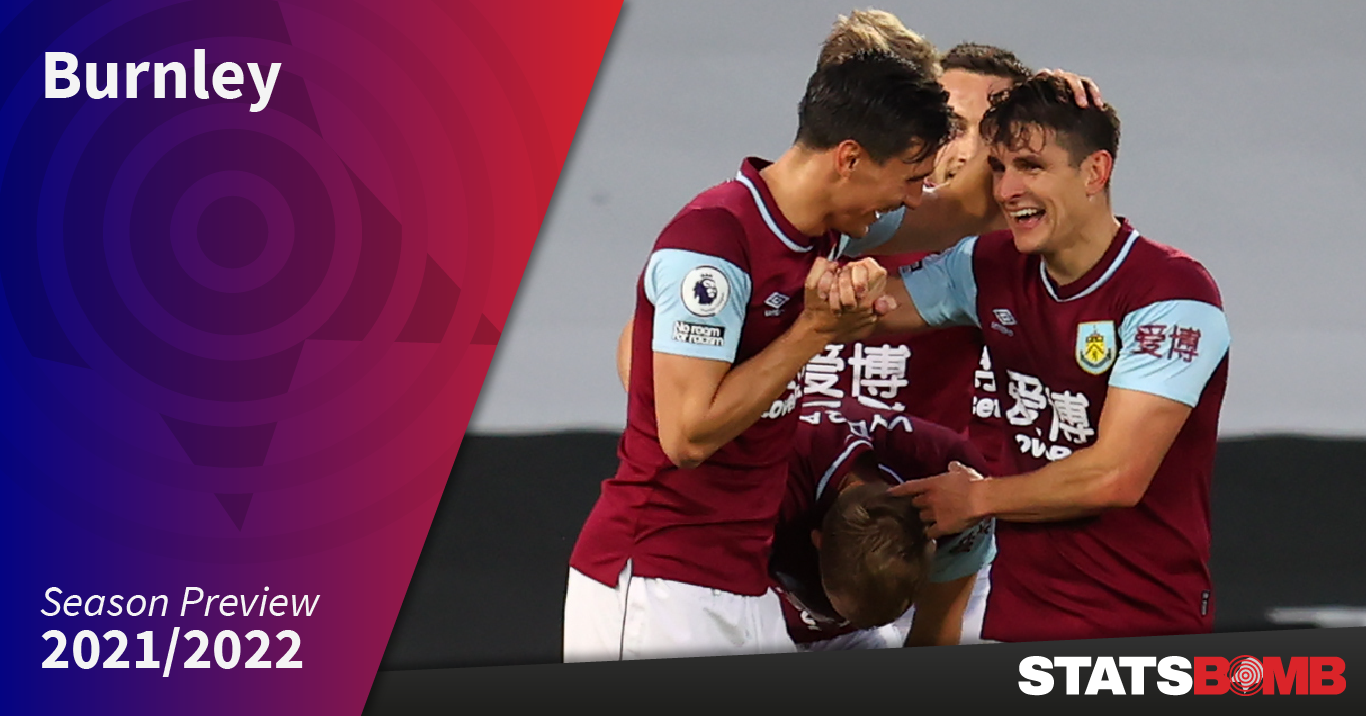Burnley FC. Sean Dyche. Bastions of consistency and stability. A slap in the face for the notion that being predictable can only be a bad thing. You know what you’re going to get from Burnley, and still they remain in the Premier League. Because Burnley are good at being Burnley, and Burnley when being Burnley are hard to stop. Turf Moor will be hosting Premier League football for the sixth season in a row. The 17th placed finish in 2020/21 represented their lowest position and points tally since promotion five years ago, so it's not unlikely that armchair pundits are to start speculating over Burnley's Premier League future. There was some regression, sure. Their expected goal (xG) difference slid back from a Burnley-best-since-they-were-promoted of -0.08 per game in 2019/20, down to -0.47 in 2020/21: 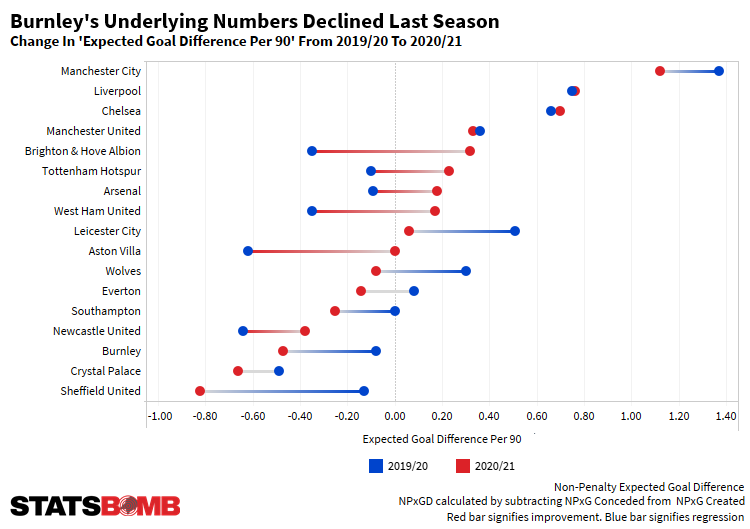 They lost 0.10 expected goals per game in attack equating to ~four goals a season, fairly negligible but still a knock, but the biggest concerns emerged at the back. You can see below that 2019/20 was a significant step forward on what came before for the team, mainly cutting out the games where they got tonked. The differences between that impressive season and last season in the graphic are not exactly apparent to the naked eye, but that in itself could perhaps be a larger red flag. Look closely. In 2019/20, the cluster of games to the right of the trendline represents games where Burnley edged out close games by xG, a valuable skill for a team trying to avoid danger. In 2020/21, a lot of games shifted both left (creating less) and up (conceding more). You can make excuses if it's a handful of really bad games making the difference, but this seemed to be a collective shift down in their performance levels. Their defence was -0.29 expected goals per game worse off than the season prior and, with the -0.10 shaved off the attack, it worked out to a ~15 goal regression over the whole season. The sort of sum that forces a team down the table--and it did.
They lost 0.10 expected goals per game in attack equating to ~four goals a season, fairly negligible but still a knock, but the biggest concerns emerged at the back. You can see below that 2019/20 was a significant step forward on what came before for the team, mainly cutting out the games where they got tonked. The differences between that impressive season and last season in the graphic are not exactly apparent to the naked eye, but that in itself could perhaps be a larger red flag. Look closely. In 2019/20, the cluster of games to the right of the trendline represents games where Burnley edged out close games by xG, a valuable skill for a team trying to avoid danger. In 2020/21, a lot of games shifted both left (creating less) and up (conceding more). You can make excuses if it's a handful of really bad games making the difference, but this seemed to be a collective shift down in their performance levels. Their defence was -0.29 expected goals per game worse off than the season prior and, with the -0.10 shaved off the attack, it worked out to a ~15 goal regression over the whole season. The sort of sum that forces a team down the table--and it did. 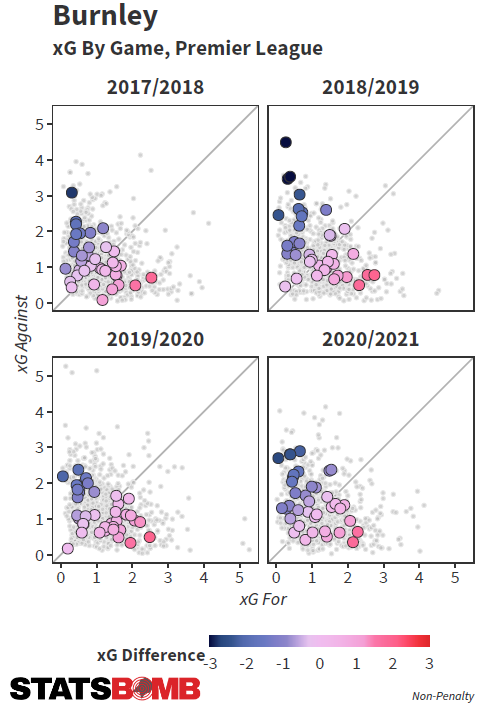 However, there is some context that needs to be applied here. Dyche regards last season as his most challenging yet in their Premier League stint. They came into the season having spent just £1million on third-choice ‘keeper Will Norris and backup midfielder Dale Stephens. Then they had to contend with injuries in the opening sequence of games: the back four in their opening day 4-2 defeat to Leicester was (right-to-left) Phil Bardsley, Kevin Long, Jimmy Dunne, and Charlie Taylor. James Tarkowski returned in game three and Ben Mee followed in game seven, but the damage had already been done: Burnley had just two points from their opening seven fixtures. The season was bookended with poor form—a W0 D2 L5 run to start, a W2 D0 L7 run to finish. But, the middle two-thirds should serve as encouragement ahead of next season. A W8 D7 L7 record works out to 1.41 points-per-game: bang on the 54 points they got the season before when extrapolated over a whole season and considering they won't have the off-field uncertainty surrounding the takeover, nor the condensed schedule to contend with, and maybe we shouldn’t be so worried about Burnley after all. Survival remains objective number one, and it was mission accomplished once again. They can't learn from it if they don't dig into what caused this decline on the pitch, so let's wield our spades on their behalf. Given their approach and mentality, the defence is where we need to examine. xG conceded per game rose from 1.17 to 1.46--where did those additional 0.29 expected goals per game come from? The biggest factor in this change was in the quality of the chances they conceded – something Burnley have notoriously thrived at. Their xG per shot conceded was 0.08 in 2019/20, 2nd-best in the league, but increased to 0.10 xG per shot conceded last season, putting them at league average. Burnley have previously opted to soak up a lot of shots while suppressing the quality of them, but they struggled with the latter last campaign. The main cause of this was that the opposition were allowed to shoot from much closer to goal than previously. There were times in 2019/20 where Burnley's low block was straight up impenetrable and their opponent's resorted to launching missiles from range in an attempt to break them out of their shell. Their opponents shot distance from goal was 17.0 metres away on average, the furthest in the league that season. This dropped to 16.4 metres in 2020/21, a small but not-insignificant change that was a big cause of the bump in their xG per shot conceded. Closer shots equals better shots. Burnley were trying the same out of possession techniques - pressing high in the first phase but then dropping right off should the opposition begin to advance - but were unable to maintain the same intensity required when bunkering, largely due to the intense schedule. It always surprises people to learn that Burnley's Defensive Distance - the average distance from their goal that they make defensive actions - has always been pretty high: behind only Manchester City and Liverpool in 2019/20, and the same pair plus Chelsea in 2020/21. They press the opposition from goal kicks and from turnovers in their attacking third, but soon sink into their defensive shape once the opposition starts to enter their half of the pitch.
However, there is some context that needs to be applied here. Dyche regards last season as his most challenging yet in their Premier League stint. They came into the season having spent just £1million on third-choice ‘keeper Will Norris and backup midfielder Dale Stephens. Then they had to contend with injuries in the opening sequence of games: the back four in their opening day 4-2 defeat to Leicester was (right-to-left) Phil Bardsley, Kevin Long, Jimmy Dunne, and Charlie Taylor. James Tarkowski returned in game three and Ben Mee followed in game seven, but the damage had already been done: Burnley had just two points from their opening seven fixtures. The season was bookended with poor form—a W0 D2 L5 run to start, a W2 D0 L7 run to finish. But, the middle two-thirds should serve as encouragement ahead of next season. A W8 D7 L7 record works out to 1.41 points-per-game: bang on the 54 points they got the season before when extrapolated over a whole season and considering they won't have the off-field uncertainty surrounding the takeover, nor the condensed schedule to contend with, and maybe we shouldn’t be so worried about Burnley after all. Survival remains objective number one, and it was mission accomplished once again. They can't learn from it if they don't dig into what caused this decline on the pitch, so let's wield our spades on their behalf. Given their approach and mentality, the defence is where we need to examine. xG conceded per game rose from 1.17 to 1.46--where did those additional 0.29 expected goals per game come from? The biggest factor in this change was in the quality of the chances they conceded – something Burnley have notoriously thrived at. Their xG per shot conceded was 0.08 in 2019/20, 2nd-best in the league, but increased to 0.10 xG per shot conceded last season, putting them at league average. Burnley have previously opted to soak up a lot of shots while suppressing the quality of them, but they struggled with the latter last campaign. The main cause of this was that the opposition were allowed to shoot from much closer to goal than previously. There were times in 2019/20 where Burnley's low block was straight up impenetrable and their opponent's resorted to launching missiles from range in an attempt to break them out of their shell. Their opponents shot distance from goal was 17.0 metres away on average, the furthest in the league that season. This dropped to 16.4 metres in 2020/21, a small but not-insignificant change that was a big cause of the bump in their xG per shot conceded. Closer shots equals better shots. Burnley were trying the same out of possession techniques - pressing high in the first phase but then dropping right off should the opposition begin to advance - but were unable to maintain the same intensity required when bunkering, largely due to the intense schedule. It always surprises people to learn that Burnley's Defensive Distance - the average distance from their goal that they make defensive actions - has always been pretty high: behind only Manchester City and Liverpool in 2019/20, and the same pair plus Chelsea in 2020/21. They press the opposition from goal kicks and from turnovers in their attacking third, but soon sink into their defensive shape once the opposition starts to enter their half of the pitch. 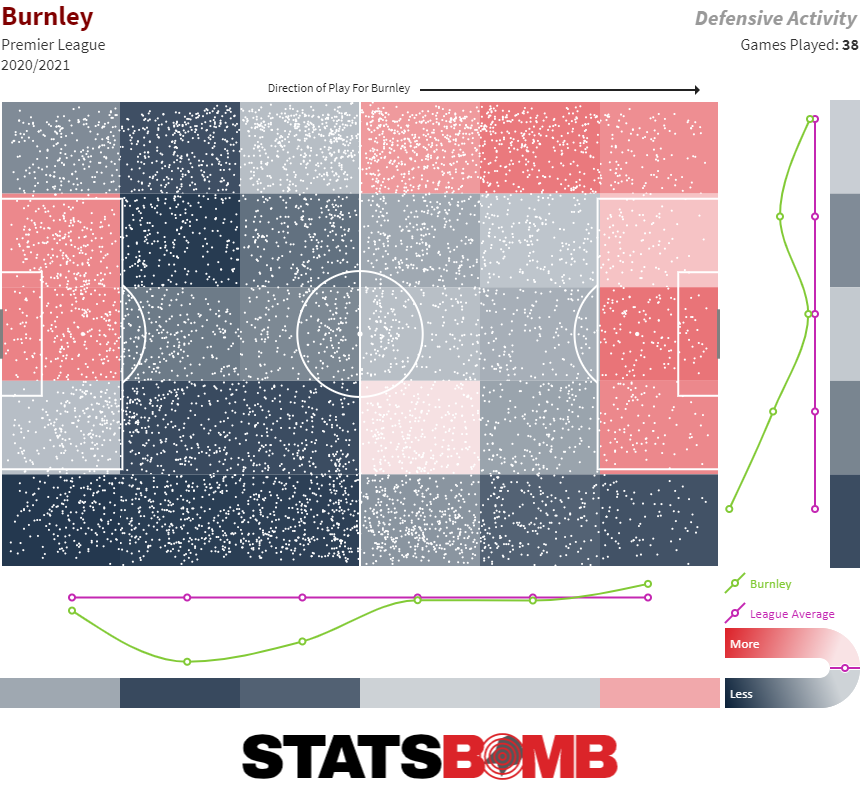 Simply, they just lacked the energy to disrupt the opposition in 2020/21. The percentage of opposition pass receipts that were pressured, tackled or fouled within two seconds dropped from 20% to 16%. Burnley have always been towards the lower end of these rankings in previous seasons, but the lost intensity clearly harmed their overall effectiveness in disrupting the opponent’s build-up and chance creation.
Simply, they just lacked the energy to disrupt the opposition in 2020/21. The percentage of opposition pass receipts that were pressured, tackled or fouled within two seconds dropped from 20% to 16%. Burnley have always been towards the lower end of these rankings in previous seasons, but the lost intensity clearly harmed their overall effectiveness in disrupting the opponent’s build-up and chance creation. 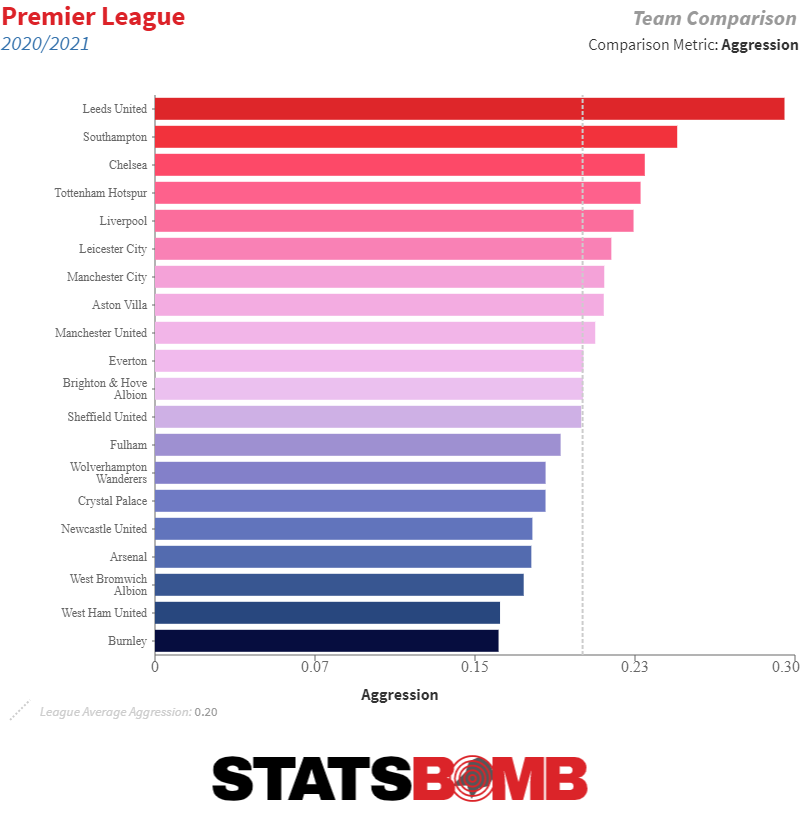 Load up the trebuchet! In possession, Burnley continued to Burnley. Their top-five most commonly used pass clusters will be familiar to regular observers:
Load up the trebuchet! In possession, Burnley continued to Burnley. Their top-five most commonly used pass clusters will be familiar to regular observers: 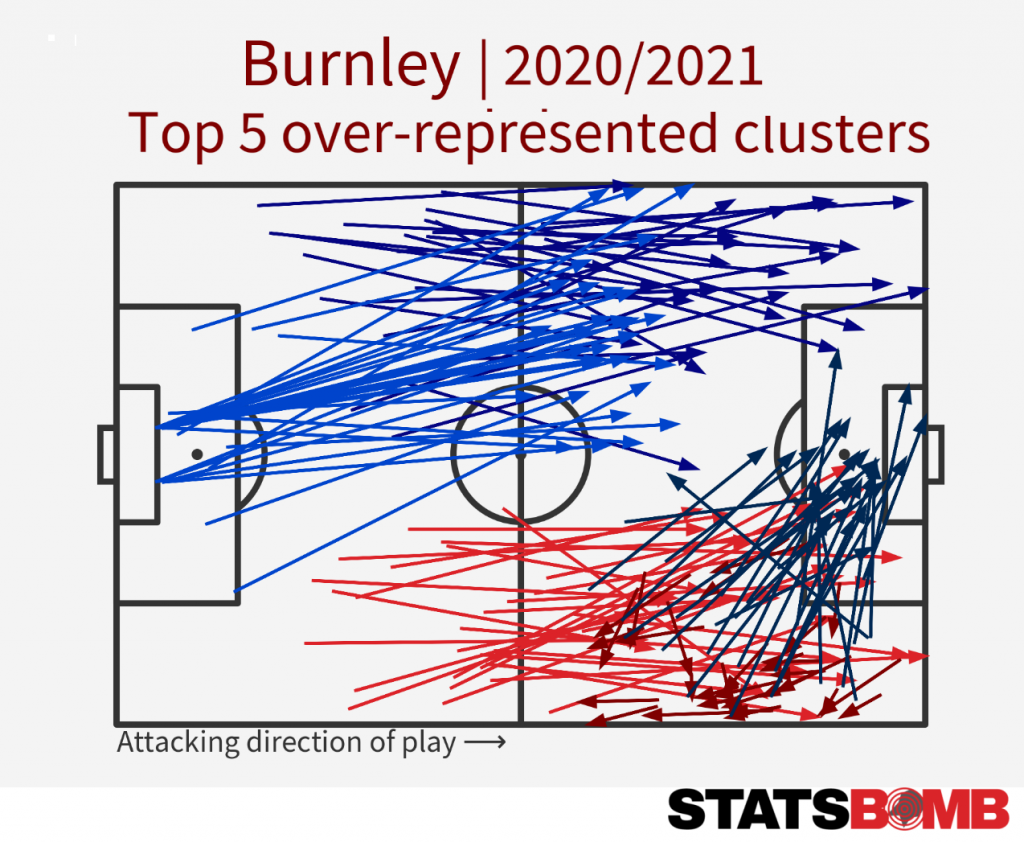 Plenty of long, high passes into the opposition half and attacking third and, once they're in there, plenty of crosses from the flank. We can see those patterns of play when examining the nine most over-represented pass clusters plotted individually:
Plenty of long, high passes into the opposition half and attacking third and, once they're in there, plenty of crosses from the flank. We can see those patterns of play when examining the nine most over-represented pass clusters plotted individually:
- Cluster #3 represents the Nick Pope pump into the opposition half
- Clusters #1 and #2 represent the channel balls played down the flanks to put the wingers in a foot race with their full backs
- Clusters #7 and #8 are shorter versions to the wingers feet
- Clusters #5 and #9 are the crosses regularly seen played into the box
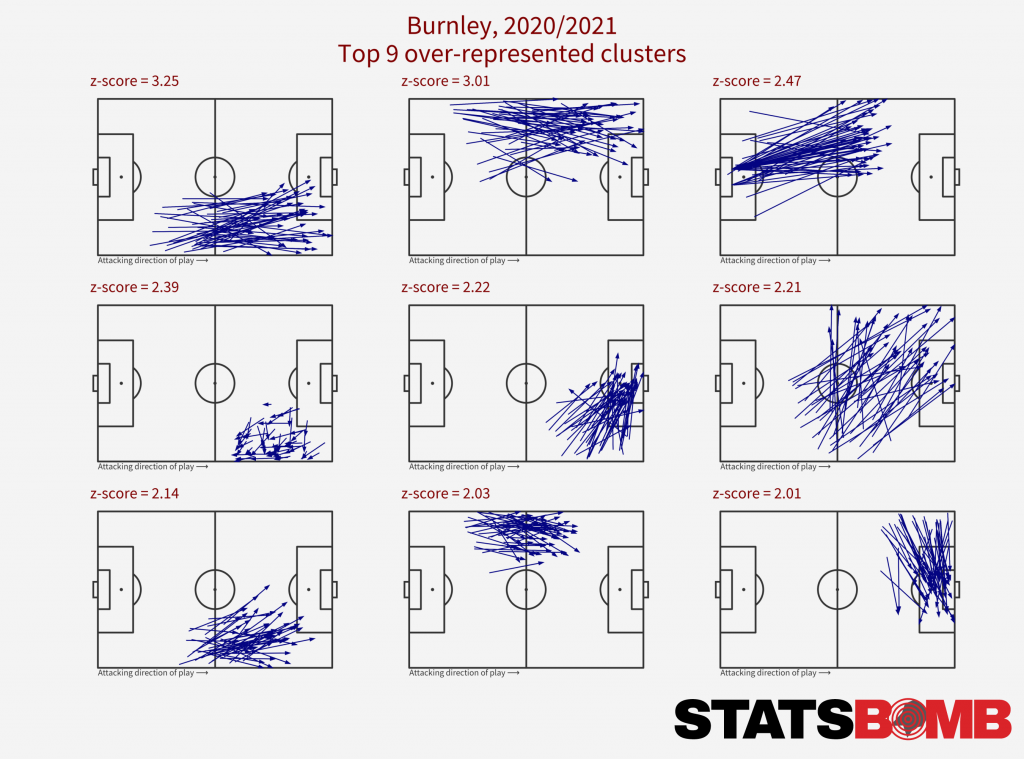 Cluster #6 is the only pass of any real range played from the middle third, and this can mostly be attributed to Ashley Westwood. Westwood’s become a steady, unheralded Premier League performer but his importance to Burnley shouldn’t go without saying. He made the most open play passes in the squad, played the ball into the final third most often, made the most passes into the penalty box in open play, AND made the most open play key passes. He clearly has the best passing range in the team, a vital attribute to the Clarets when they do need to play through the middle third, and completed by far the most switches of play of his Burnley teammates.
Cluster #6 is the only pass of any real range played from the middle third, and this can mostly be attributed to Ashley Westwood. Westwood’s become a steady, unheralded Premier League performer but his importance to Burnley shouldn’t go without saying. He made the most open play passes in the squad, played the ball into the final third most often, made the most passes into the penalty box in open play, AND made the most open play key passes. He clearly has the best passing range in the team, a vital attribute to the Clarets when they do need to play through the middle third, and completed by far the most switches of play of his Burnley teammates. 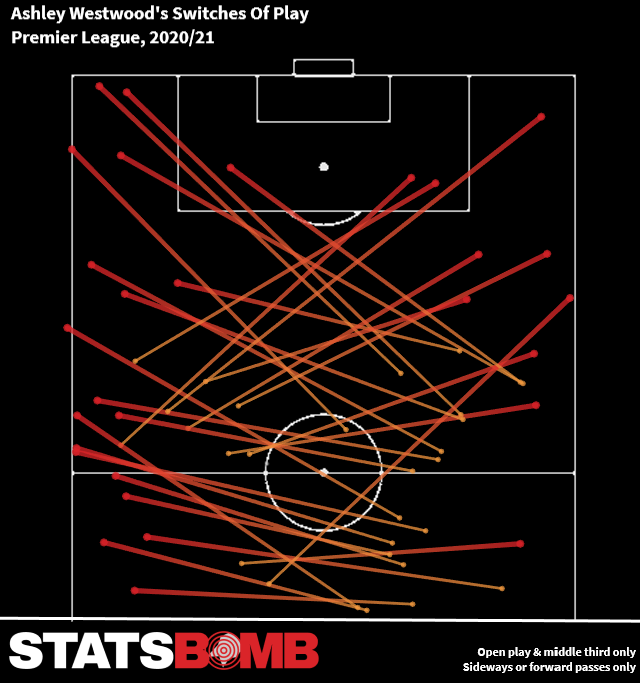 What I’m about to say next may shock you*, so make sure you're sitting down: Burnley played the most high-passes in the league, both in absolute terms and as a percentage of their total passes. Of their passes into the final third, 44% of them were high-passes - a league-high -, and the value of those passes are captured in our new possession value model, On-Ball Value, which estimates the extent to which an action improves a team's expected goal difference over the next two possessions. Burnley accrued the most OBV from high-passes in the whole league. *just kidding
What I’m about to say next may shock you*, so make sure you're sitting down: Burnley played the most high-passes in the league, both in absolute terms and as a percentage of their total passes. Of their passes into the final third, 44% of them were high-passes - a league-high -, and the value of those passes are captured in our new possession value model, On-Ball Value, which estimates the extent to which an action improves a team's expected goal difference over the next two possessions. Burnley accrued the most OBV from high-passes in the whole league. *just kidding 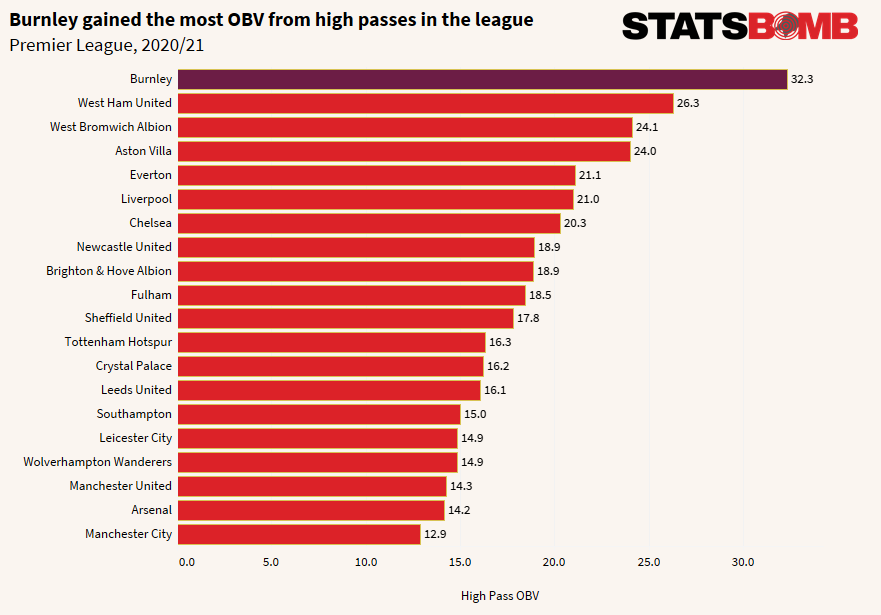 And their danger from crosses remained. Unlike most teams in the modern era, they’re not as bothered about crossing from closer to the byline and the goal in general. Instead, Burnley look to get the ball into the mixer much faster, with Chris Wood, Ashley Barnes, and Matěj Vydra all well attuned to attacking the early balls into the box.
And their danger from crosses remained. Unlike most teams in the modern era, they’re not as bothered about crossing from closer to the byline and the goal in general. Instead, Burnley look to get the ball into the mixer much faster, with Chris Wood, Ashley Barnes, and Matěj Vydra all well attuned to attacking the early balls into the box. 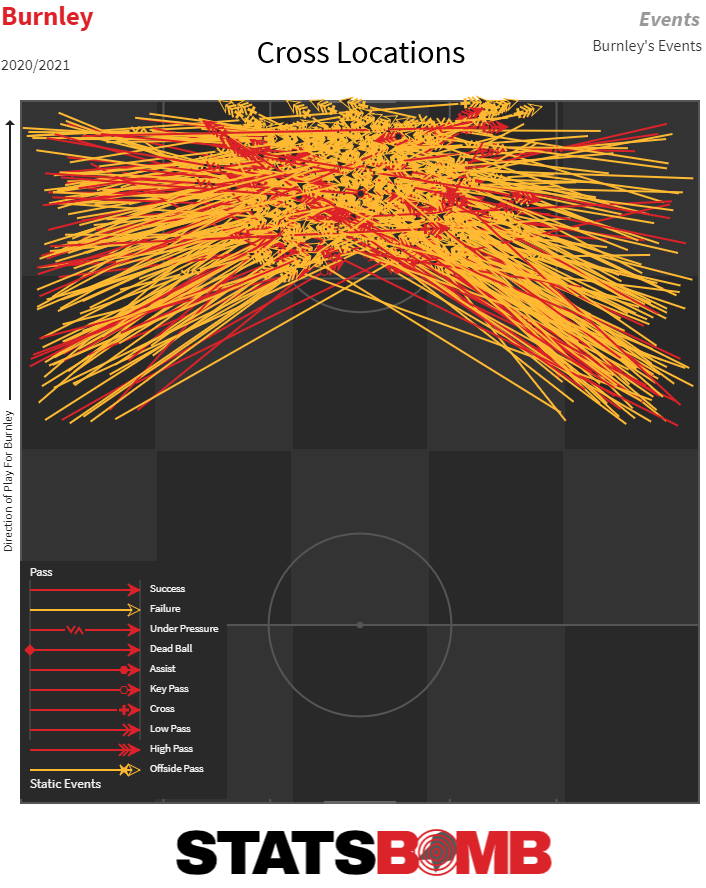 Crossing from deep can be more difficult to execute, but it does have its upsides. Because Burnley get the ball forward so quickly (their Pace To Goal of 3.04 m/s was second only to West Ham), they’re often able to attack against unset defences, meaning their attackers can often have more space and less competition to attack the ball when it’s played into the box. Thanks to StatsBomb 360 data, we can now measure how many attackers versus how many defenders teams have in the box on crosses, and can see that Burnley attackers averaged the least competition in the box (measured by attackers in the box minus defenders in the box) in the whole league.
Crossing from deep can be more difficult to execute, but it does have its upsides. Because Burnley get the ball forward so quickly (their Pace To Goal of 3.04 m/s was second only to West Ham), they’re often able to attack against unset defences, meaning their attackers can often have more space and less competition to attack the ball when it’s played into the box. Thanks to StatsBomb 360 data, we can now measure how many attackers versus how many defenders teams have in the box on crosses, and can see that Burnley attackers averaged the least competition in the box (measured by attackers in the box minus defenders in the box) in the whole league. 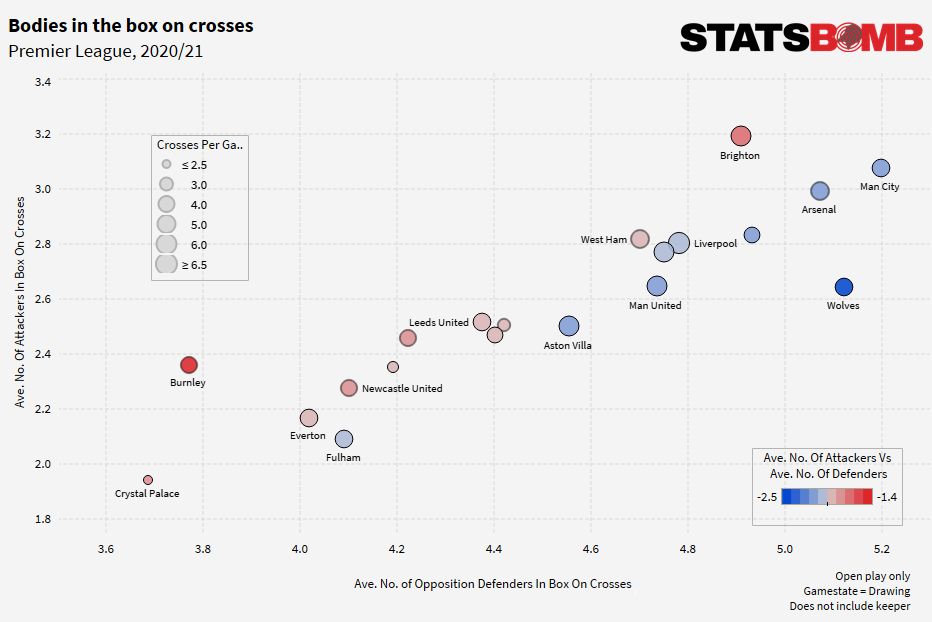 Knowing Burnley as we do, we can expect the same again next season. Likewise, we can expect the same playing squad. Dyche's squadron has been together for several seasons now, with very little surgery performed in the last few transfer windows. Cohesive, yes, but the squad's age profile is starting to veer dangerously close to post-peak territory, where we can start to expect a simultaneous decline in performances from several key members of the squad. Some botox is required sooner rather than later. Dwight McNeil and Josh Brownhill were the only players below the league average age to play a significant number of minutes.
Knowing Burnley as we do, we can expect the same again next season. Likewise, we can expect the same playing squad. Dyche's squadron has been together for several seasons now, with very little surgery performed in the last few transfer windows. Cohesive, yes, but the squad's age profile is starting to veer dangerously close to post-peak territory, where we can start to expect a simultaneous decline in performances from several key members of the squad. Some botox is required sooner rather than later. Dwight McNeil and Josh Brownhill were the only players below the league average age to play a significant number of minutes. 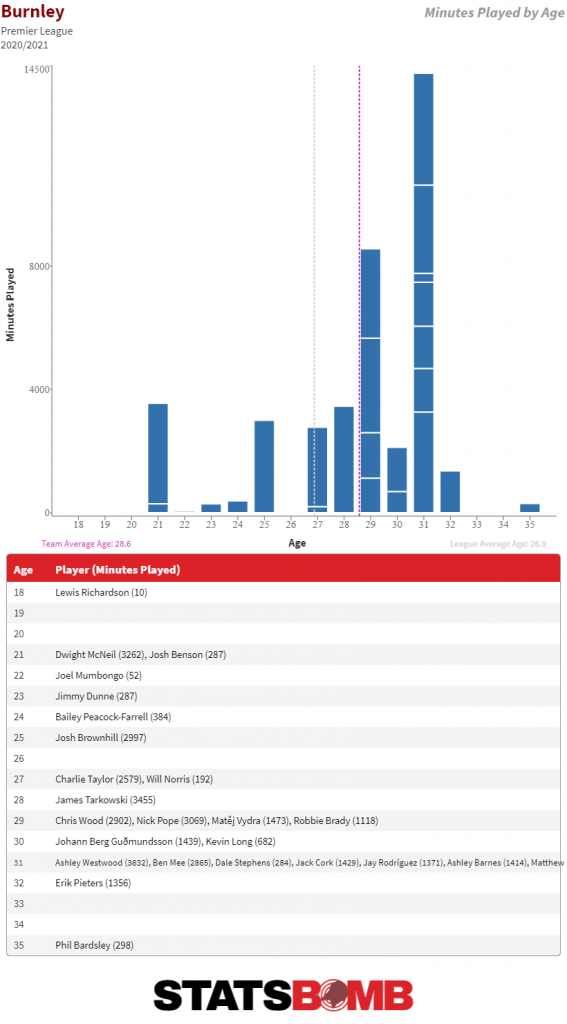 You have to go all the way down to their 16th most-used player last season, Robbie Brady, to find one who has left the club this summer. This is no bad thing in a squad full of dependable performers, but the sense that some fresh blood is required is most certainly there. In transfer news, Wayne Hennessey’s signed as ‘keeper cover, but the main (and only other) signing has been that of Irish beanpole Nathan Collins from Stoke, a signing that does start to provide a solution to their age problem. A promising centre-half who’s impressed in significant Championship minutes, Collins represents an heir to the throne of Tarkowski and Mee, and will shadow them for minutes in the middle of the defence next season, but also at right back as he integrates into the squad. Projection In context, there’s no reason to think Burnley should perform any worse than they did last season, which was enough to stay up albeit not much more. With a more relaxed schedule and more stability off the field, they should be able to get back to what they do best, but question marks remain over whether an aging squad can implement Dyche’s gameplan with the required energy levels-- something that cost them defensively last season, as described earlier in the piece. The betting markets have benchmarked them for a repeat of the 39 points accrued in 2020/21, 16th in the market and in the mix with the promoted sides plus Newcastle and Palace, and without any major (or even minor) investment in the squad, that feels fair. Survival is the aim, again.
You have to go all the way down to their 16th most-used player last season, Robbie Brady, to find one who has left the club this summer. This is no bad thing in a squad full of dependable performers, but the sense that some fresh blood is required is most certainly there. In transfer news, Wayne Hennessey’s signed as ‘keeper cover, but the main (and only other) signing has been that of Irish beanpole Nathan Collins from Stoke, a signing that does start to provide a solution to their age problem. A promising centre-half who’s impressed in significant Championship minutes, Collins represents an heir to the throne of Tarkowski and Mee, and will shadow them for minutes in the middle of the defence next season, but also at right back as he integrates into the squad. Projection In context, there’s no reason to think Burnley should perform any worse than they did last season, which was enough to stay up albeit not much more. With a more relaxed schedule and more stability off the field, they should be able to get back to what they do best, but question marks remain over whether an aging squad can implement Dyche’s gameplan with the required energy levels-- something that cost them defensively last season, as described earlier in the piece. The betting markets have benchmarked them for a repeat of the 39 points accrued in 2020/21, 16th in the market and in the mix with the promoted sides plus Newcastle and Palace, and without any major (or even minor) investment in the squad, that feels fair. Survival is the aim, again.
Want to read about another team? The rest of our Premier League season previews can be found here If you're a club, media or gambling entity and want to know more about what StatsBomb can do for you, please contact us at Sales@StatsBomb.com We also provide education in this area, so if this taste of football analytics sparked interest, check out our Introduction to Football Analytics course Follow us on Twitter in English and Spanish and also on LinkedIn
